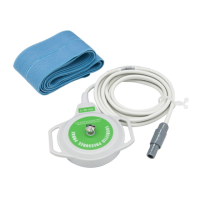Cadence II Fetal Monitor Service Manual
- 10 -
(9) Fetal Movement Marker
Manual fetal movement mark
(10) AFM
Technique: Pulsed Doppler ultrasound
Range: 0-100 (%)
Resolution: 1%
Gain Control: Manual/ Automatic
1.3 Fetal Monitor Operation Principle
The first and the second generation fetal monitors used previously detect FHR with high
frequency continuous ultrasonic waves. Continuous ultrasonic waves can’t control
distance gate, and easy to be interfered by other movement organ and adult trunk blood
vessel movement signal. The fetus suffers more ultrasonic radiation than pulsed wave.
The third generation fetal monitor adopts low frequency pulsed wave ultrasound, The
ultrasonic signal controlled by Doppler gate transmits pulsed waves with specific
frequency to fetal heart, and it’s hard to be interfered.
The first and the second generation fetal monitors calculate FHR by measuring the
interval time of Doppler signal peak values. While modern fetal monitor calculates FHR
using digital signal processing auto-correlation arithmetic. Auto-correlation operation
creates characteristic parameter via processing Doppler echo signal. Comparing new
characteristic parameter created by new signal with the former one, and obtain the data
of FHR display and recorder updating. Auto-correlation operation decreases additional
artificial signal effectively, and only extracts effective echo signal that can deduce FHR.
The detection of external TOCO is obtained by indirect measurement via displacement
transducer (TOCO) binding at maternal abdominal wall.
Operation Principle of Ultrasound Doppler FHR Monitoring
Ultrasound transducer is made up of a group of quincunx multi-wafer piezoelectricity
transducers. The CADENCE II ultrasound transducer is made up of nine pieces of
piezoelectric crystals with uniform distributed eight pieces constituting a circle, and one
lying at the center of a circle. Transducer transmits / receives switch under the control of
transmitting / receiving timing pulse given by system timer. Receiver will be closed
during transmitting. It can receive Doppler frequency shift information of fetal heart when

